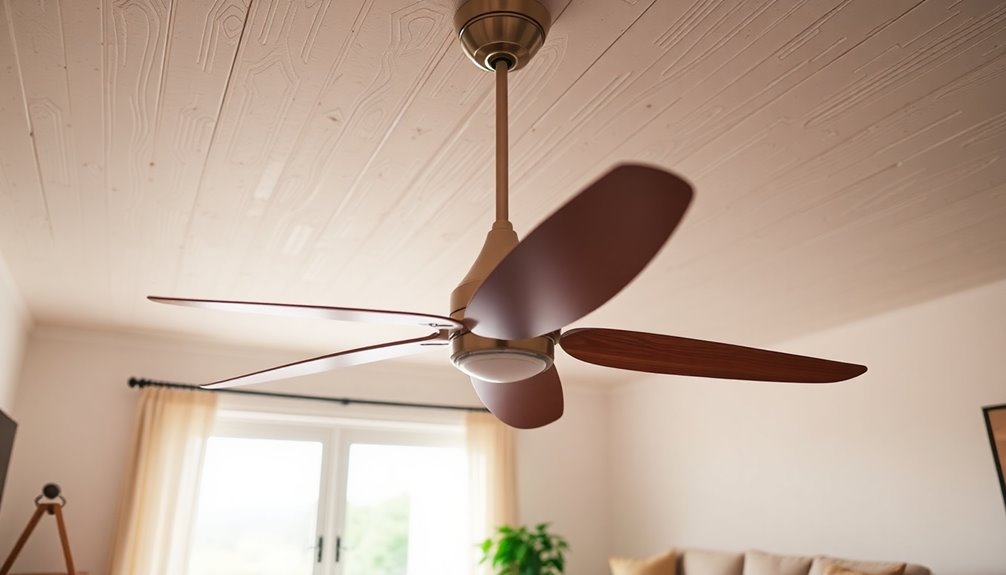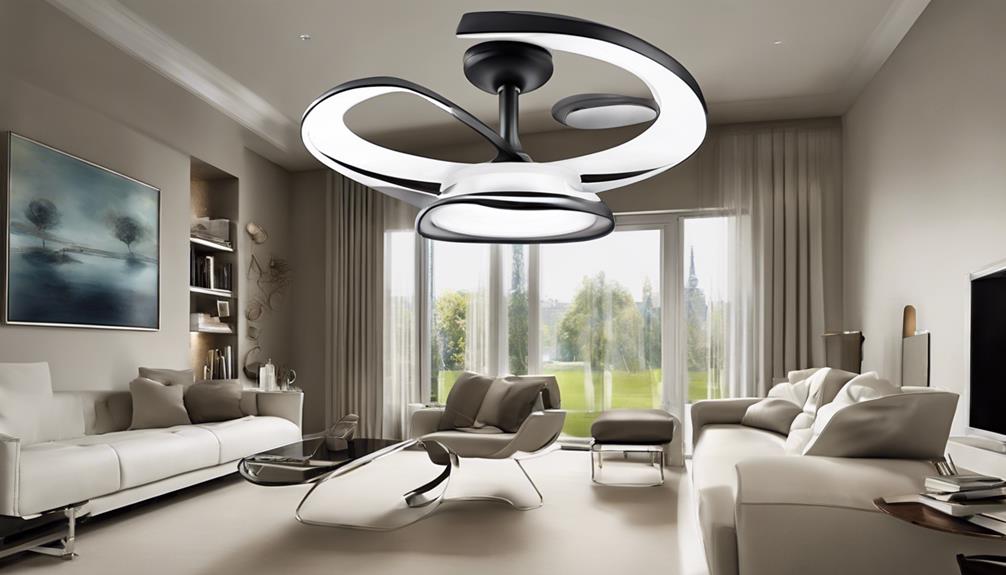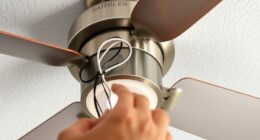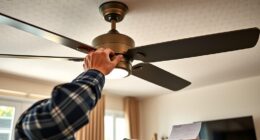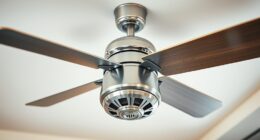Your ceiling fan should spin counterclockwise in the summer to create a cooling downdraft. This helps you feel cooler without relying too much on air conditioning, saving you energy costs. In winter, change the spin direction to clockwise at a low speed. This redistributes warm air throughout the room and can cut heating expenses. You should adjust your ceiling fan's direction with the seasons, ideally aligning with Daylight Savings Time changes. Proper use of a ceiling fan can enhance comfort and efficiency. If you're curious about more tips on ceiling fan use, keep exploring!
Key Takeaways
- Summer Direction: Ceiling fans should spin counterclockwise to create a cooling downdraft and enhance comfort.
- Winter Direction: Set fans to spin clockwise at low speed to redistribute warm air and improve heating efficiency.
- Adjust with Seasons: Change fan direction with Daylight Savings Time; counterclockwise in spring and clockwise in fall.
- Room-Specific Settings: Use medium clockwise speed in home offices and dining rooms to avoid discomfort and maintain food temperature.
- Outdoor Fans: For outdoor settings, run fans counterclockwise at high speed to provide a breeze and control insects.
Importance of Ceiling Fan Direction

The direction your ceiling fan spins plays a crucial role in your home's comfort and energy efficiency. When you choose the right fan direction in summer, you create a cooling downdraft that helps you feel cooler without cranking up the air conditioning. By adjusting the ceiling fan blades to rotate counterclockwise, you enhance airflow throughout the room, making those hot days more bearable.
It's essential to change the direction of your ceiling fan blades with the seasons. In summer, a counterclockwise spin keeps you cool, while in winter, switching to a clockwise rotation generates an updraft. This redistributes warm air trapped near the ceiling, improving heating efficiency and ensuring you stay cozy during colder months. Additionally, proper airflow can lead to better respiratory health, as it helps maintain a balanced indoor environment.
Failing to adjust your fan direction can lead to inadequate airflow, leaving you uncomfortable and relying more heavily on your HVAC system.
Seasonal Fan Direction Guidelines
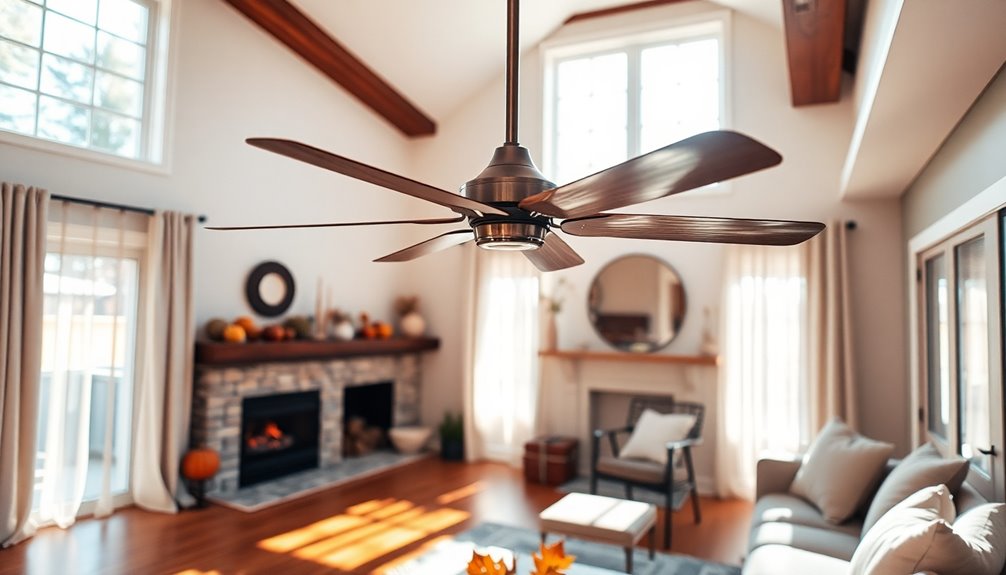
Adjusting your ceiling fan direction seasonally is key to maximizing comfort and energy efficiency.
By making a simple change, you can enhance your home's ambiance while saving on energy bills.
Here's how to manage your fan direction effectively:
- Summer: Set your ceiling fan direction to counterclockwise. This creates a cooling downdraft, helping to lower the room temperature and reduce your reliance on air conditioning.
- Winter: Switch the fan to rotate clockwise at a low speed. This pushes warm air down from the ceiling, redistributing heat throughout the room and keeping you cozy.
- Timing: An ideal time to change your fan direction is during Daylight Savings Time.
This seasonal adjustment can help maintain a comfortable average temperature, potentially leading to energy savings of up to 30% in summer and 15% in winter.
Changing Ceiling Fan Direction

Changing the direction of your ceiling fan is a straightforward process that can enhance your comfort throughout the year. To start, verify the fan is off and has come to a complete stop before making any adjustments.
Here's a quick guide based on the type of fan you have:
| Fan Type | Direction Change Method |
|---|---|
| Pull Chain Fans | Use the direction switch on the fan body to toggle the blades. |
| Remote-Controlled Fans | Turn off the fan, press and hold the fan button on the remote until the light blinks. |
| Smart Fans | Adjust using SIMPLEconnect® WiFi® technology or compatible voice commands. |
If you want to cool down a room, remember to change the ceiling fan to turn counterclockwise. This creates a breeze effect. After you've made the change, don't forget to turn the fan back on to confirm it's operating in the new desired direction. Enjoy the enhanced comfort that comes with the right ceiling fan settings!
Timing for Direction Change
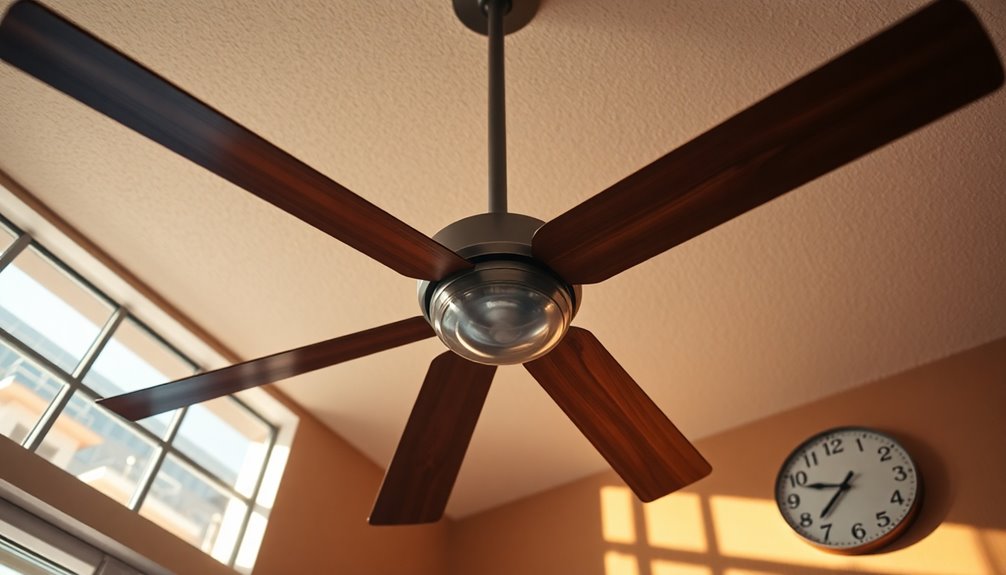
The best time to change your ceiling fan's direction is during Daylight Savings Time adjustments.
When you spring forward, set it to spin counterclockwise for summer, and switch to clockwise when you fall back for winter.
These seasonal changes not only improve your comfort but also boost energy efficiency throughout the year.
Daylight Savings Time Adjustment
Twice a year, you have the perfect opportunity to optimize your ceiling fan's performance with the shift in Daylight Savings Time.
As the seasons change, adjusting your ceiling fan direction can greatly impact your comfort and energy efficiency.
Here's how to make those adjustments effectively:
- Spring Forward (March): When you set your clocks ahead, switch your ceiling fan to spin counterclockwise. This direction creates a cool breeze, helping you stay comfortable as the temperatures rise.
- Fall Back (November): As you turn the clocks back, change your fan to spin clockwise. This will help circulate warm air that rises, keeping your space cozy during the colder months.
- Optimal Performance: Remember, ensuring your ceiling fan is appropriately sized for the room also enhances its effectiveness throughout the year.
Seasonal Direction Changes
Adjusting your ceiling fan direction at the right time can greatly enhance your comfort based on the season. To maximize efficiency, consider making these changes during Daylight Savings Time adjustments. Set your fan to spin counterclockwise in the spring for summer cooling, and switch it to clockwise in the fall for winter heating.
Here's a quick reference:
| Season | Ceiling Fan Direction | Purpose |
|---|---|---|
| Summer | Counterclockwise | Cooling |
| Winter | Clockwise | Heating |
Before making these changes, verify the fan is turned off and has completely stopped. This not only guarantees safety but also maintains the fan's functionality. Additionally, using a fan that's the right size for your room is essential for peak performance. Regularly changing your ceiling fan direction can lead to significant energy savings—up to 30% in summer and 15% in winter. By aligning your fan's direction with seasonal temperature needs, you can enjoy improved comfort while reducing your heating and cooling costs.
Ceiling Fan Direction in Specific Rooms

Creating the right ambiance in your home often hinges on the subtle yet impactful direction of your ceiling fan. Knowing how to adjust the ceiling fan direction based on the specific room can enhance comfort and functionality. Here are some tips for different spaces:
- Dining Room: Set the fan to rotate clockwise at medium to low speed. This prevents cooling food too quickly while keeping the atmosphere comfortable for your guests.
- Home Office: Use a medium clockwise setting here to avoid blowing papers around. This helps maintain focus and creates a productive workspace.
- Vaulted Ceilings: Keep the fan on counterclockwise year-round. This minimizes wind chill and guarantees comfort without excessive air movement.
In spaces where smoking occurs, a clockwise direction helps draw smoke upward, so make sure you have proper ventilation.
For outdoor fans, set them to counterclockwise at high speed to aid insect control and provide a revitalizing breeze on hot days.
General Ceiling Fan Tips
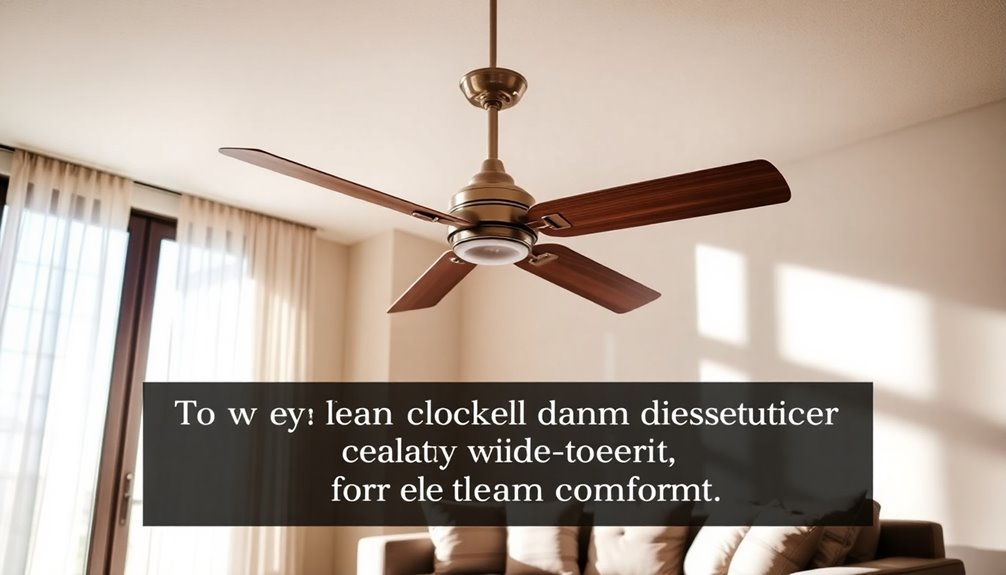
To get the most out of your ceiling fan, make certain it's mounted at the right height for ideal airflow.
Regular maintenance is key to keeping it running efficiently, so don't skip on cleaning those blades and checking the motor.
Optimal Fan Height
Finding the right height for your ceiling fan is essential for maximizing airflow and comfort in your space. Installing your fan at the ideal ceiling fan height can greatly enhance air circulation, making your room feel more comfortable year-round. Here are some key guidelines to follow:
- Height: Aim for your fan to be 7 to 9 feet above the floor. This height guarantees ideal airflow and prevents discomfort from drafts.
- Clearance: Maintain at least 10 inches of space between the fan blades and the ceiling. This distance prevents airflow obstruction and allows for efficient air circulation.
- Wall Clearance: Make sure there's at least 18 inches of clearance from the fan blades to any walls. This spacing further promotes effective air circulation, increasing your fan's efficiency.
If you have vaulted ceilings, don't forget to use a down rod to achieve the correct height.
Regularly checking and tightening screws and bolts will also help keep your fan operating safely and efficiently.
Regular Maintenance Importance
Regular maintenance of your ceiling fan is essential for ensuring it runs efficiently and lasts longer. Regular cleaning of the blades and motor is key to maintaining efficiency and reducing energy use. Dust and grime can accumulate, hindering its performance. Make it a habit to wipe down the blades and check the motor to keep everything running smoothly.
When you leave a room, don't forget to turn off the fan. Remember, ceiling fans don't cool the room; they create a wind chill effect for you.
Additionally, regularly inspect and tighten screws and bolts to prevent wobbling. This simple step can save your fan from potential damage and keep it securely mounted.
Check the blade pitch and alignment too. If you notice little to no air movement, it may indicate a failing motor or flat blade pitch.
Energy Savings With Ceiling Fans
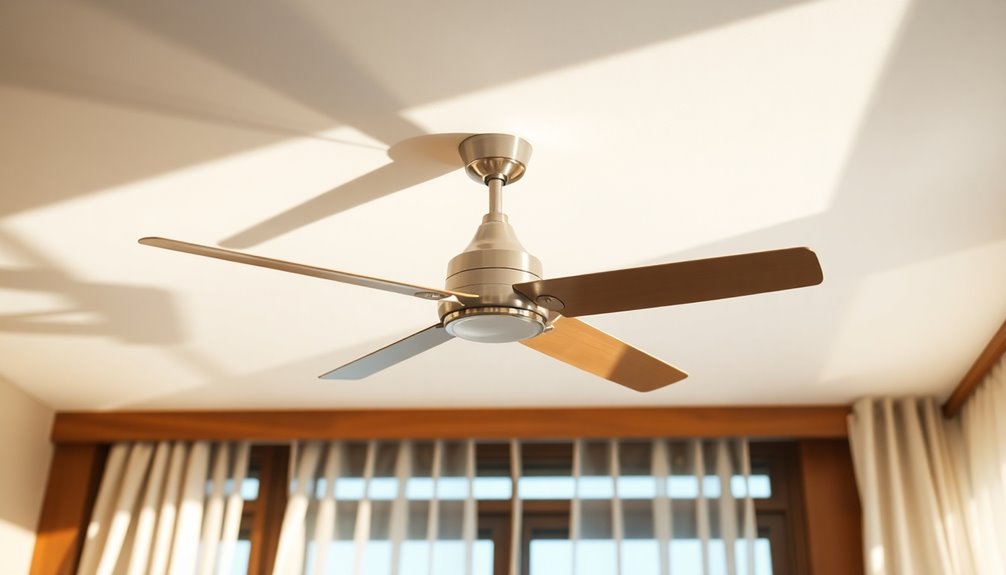
Ceiling fans can considerably lower your energy costs, offering up to 30% savings on cooling expenses during the summer months.
By setting your ceiling fan direction to counterclockwise, you create a cooling downdraft that allows you to raise your thermostat setting while still enjoying cool air.
Here are some key benefits of using ceiling fans:
- Energy Efficiency: A ceiling fan typically uses about 50 watts of energy, compared to 3,500 watts for an air conditioner. This makes it a cost-effective option for managing temperatures and complements energy-efficient heat pumps for even greater savings. Additionally, using ceiling fans can help improve overall indoor air quality when combined with air purifiers. Furthermore, when used alongside heat pumps, ceiling fans can enhance overall system efficiency and comfort. This synergy can be particularly effective in systems that utilize the refrigeration cycle for thermal energy transfer.
- Year-Round Savings: Running the fan in winter at low speed and clockwise can reduce heating bills by up to 15% by redistributing warm air that collects near the ceiling.
- Enhanced Cooling: Pair your ceiling fan with an ENERGY STAR-rated air conditioner to enhance cooling efficiency by up to 8%, further cutting down on energy costs. Additionally, using fans in combination with heat pump systems can optimize energy savings and improve overall comfort in your home.
Frequently Asked Questions
Which Direction Should a Ceiling Fan Turn in the Summer?
In the summer, you want your ceiling fan to spin counterclockwise. This direction creates a cooling downdraft that makes the room feel much cooler, enhancing your comfort.
By running the fan at a higher speed, you'll maximize airflow and can even set your thermostat higher, saving energy costs.
Just stand underneath the fan and feel for a revitalizing breeze to confirm it's rotating correctly. It's an easy way to improve your indoor environment!
What Direction Should I Face My Fan?
When you're deciding which direction to face your fan, consider where you want the airflow to go.
If you want to feel a breeze while sitting in a specific area, angle the fan towards that spot.
If you're aiming to circulate air throughout the room, position it in a way that allows for maximum airflow.
Which Way Should a Ceiling Fan Turn in Summer Reddit?
Imagine standing in a sweltering room, beads of sweat forming on your forehead.
You've got a ceiling fan, but which way should it turn in summer?
It should spin counterclockwise. This direction creates an invigorating downdraft, making you feel cooler and allowing you to raise the thermostat a bit.
Plus, it can save you up to 30% on energy costs.
How to Tell Fan Direction?
To tell the fan direction, start by turning it on at a low speed.
Stand beneath it and observe how the blades move. If you feel a cooling breeze, it's spinning counterclockwise; a gentle updraft means it's clockwise.
If you've got a remote, check its settings for directional options.
For pull chain fans, look for the reversing switch on the body, but make certain the fan's off before adjusting it.
Regular checks improve airflow efficiency!
Conclusion
In the dance of air, your ceiling fan plays a pivotal role in your comfort. By adjusting its direction with the seasons, you can keep your home cozy in winter and pleasantly cool in summer. Don't forget to change it at the right time and consider each room's needs. With a few simple tweaks, you'll not only enhance your living space but also save on energy costs. So, let your fan spin in harmony with the seasons!
